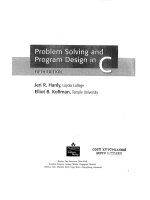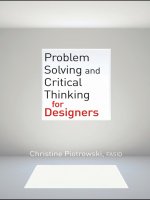problem solving and critical thinking for designers
Bạn đang xem bản rút gọn của tài liệu. Xem và tải ngay bản đầy đủ của tài liệu tại đây (3.45 MB, 194 trang )
P1: OTA/XYZ P2: ABC
fm JWBT456-Piotrowski January 24, 2011 15:39 Printer Name: Courier Westford, Westford, MA
P1: OTA/XYZ P2: ABC
fm JWBT456-Piotrowski January 24, 2011 15:39 Printer Name: Courier Westford, Westford, MA
Problem Solving
and Critical
Thinking for
Designers
Christine M. Piotrowski, FASID, IIDA
JOHN WILEY & SONS, INC.
P1: OTA/XYZ P2: ABC
fm JWBT456-Piotrowski January 24, 2011 15:39 Printer Name: Courier Westford, Westford, MA
This book is printed on acid-free paper.
∞
Copyright
C
2011 by Christine M. Piotrowski. All rights reserved
Published by John Wiley & Sons, Inc., Hoboken, New Jersey
Published simultaneously in Canada
No part of this publication may be reproduced, stored in a retrieval system, or
transmitted in any form or by any means, electronic, mechanical,
photocopying, recording, scanning, or otherwise, except as permitted under
Section 107 or 108 of the 1976 United States Copyright Act, without either the
prior written permission of the Publisher, or authorization through payment of
the appropriate per-copy fee to the Copyright Clearance Center, 222 Rosewood
Drive, Danvers, MA 01923, (978) 750-8400, fax (978) 646-8600, or on the web at
www.copyright.com. Requests to the Publisher for permission should be
addressed to the Permissions Department, John Wiley & Sons, Inc., 111 River
Street, Hoboken, NJ 07030, (201) 748-6011, fax (201) 748-6008, or online at
www.wiley.com/go/permissions.
Limit of Liability/Disclaimer of Warranty: While the publisher and the author
have used their best efforts in preparing this book, they make no
representations or warranties with respect to the accuracy or completeness of
the contents of this book and specifically disclaim any implied warranties of
merchantability or fitness for a particular purpose. No warranty may be
created or extended by sales representatives or written sales materials. The
advice and strategies contained herein may not be suitable for your situation.
You should consult with a professional where appropriate. Neither the
publisher nor the author shall be liable for any loss of profit or any other
commercial damages, including but not limited to special, incidental,
consequential, or other damages.
For general information about our other products and services, please contact
our Customer Care Department within the United States at (800) 762-2974,
outside the United States at (317) 572-3993 or fax (317) 572-4002.
Wiley also publishes its books in a variety of electronic formats. Some content
that appears in print may not be available in electronic books. For more
information about Wiley products, visit our web site at www.wiley.com.
Library of Congress Cataloging-in-Publication Data:
Piotrowski, Christine M., 1947-
Problem solving and critical thinking for designers/
Christine M. Piotrowski.
p. cm.
Includes index.
ISBN 978-0-470-53671-1 (pbk.); ISBN 978-0-470-95105-7 (ebk.);
ISBN 978-0-470-95122-4 (ebk.); ISBN 978-1-118-01562-9 (ebk.);
ISBN 978-1-118-01563-6 (ebk.); ISBN 978-1-118-01564-3 (ebk.)
1. Architectural design–Decision making–Problems, exercises, etc.
2. Interior architecture–Decision making–Problems, exercises, etc. I. Title.
NA2750.P54 2011
729–dc22 2010043328
Printed in the United States of America
10987654321
P1: OTA/XYZ P2: ABC
fm JWBT456-Piotrowski January 24, 2011 15:39 Printer Name: Courier Westford, Westford, MA
I dedicate this book to my nieces Julie and Jennifer who as
wives, mothers, and professionals think critically, problem
solve, and make decisions every day.
P1: OTA/XYZ P2: ABC
fm JWBT456-Piotrowski January 24, 2011 15:39 Printer Name: Courier Westford, Westford, MA
“If you already know what you are after, there is
usually not much point in looking.”
—Tim Brown, Change by Design
P1: OTA/XYZ P2: ABC
fm JWBT456-Piotrowski January 24, 2011 15:39 Printer Name: Courier Westford, Westford, MA
Contents
Preface ix
Acknowledgments xiii
CHAPTER 1
Thinking Critically 1
What Is Critical Thinking? 2
Who Is a Critical Thinker? 4
The Importance of Thinking Critically in Interior Design 5
It Is Not Criticism 8
Conclusion 9
For Discussion 10
CHAPTER 2
Design as Process 13
The Design Process—A Brief Review 14
For Whom Do We Design? 19
Not the First Answer 23
Using Time Effectively 25
Design Thinking 26
Conclusion 30
For Discussion 31
v
P1: OTA/XYZ P2: ABC
fm JWBT456-Piotrowski January 24, 2011 15:39 Printer Name: Courier Westford, Westford, MA
vi CONTENTS
CHAPTER 3
Problem Definition and Analysis 35
Goals and Objectives 36
Problem Definition 42
Problem Analysis 44
Synthesis 48
Design Concept Statements 52
Conclusion 57
For Discussion 58
CHAPTER 4
Asking Questions 63
The Purpose of Asking Questions 64
Listening Skills 68
Asking the Right Questions 71
Is There Always a Right Answer? 77
Bias 80
Avoiding Disputes 81
Negotiation 84
Conclusion 86
For Discussion 87
CHAPTER 5
Looking for Answers—Research
Methodologies 93
Types of Research 94
Evidence-Based Design 96
Developing a Research Project 101
Assessing Information 115
Assessing Information from the Internet 121
Conclusion 123
For Discussion 124
P1: OTA/XYZ P2: ABC
fm JWBT456-Piotrowski January 24, 2011 15:39 Printer Name: Courier Westford, Westford, MA
CONTENTS vii
CHAPTER 6
Decision Making 129
Making Decisions 130
What Constitutes Decision Making? 131
Decision-Making Strategies 134
Why We Make Wrong Decisions 140
Conclusion 143
For Discussion 143
CHAPTER 7
Ethical Decision Making 149
The Importance of Ethical Decision Making 150
Business versus Ethical Conflicts 153
Client Expectations 157
Conclusion 159
For Discussion 160
References 167
Index 175
P1: OTA/XYZ P2: ABC
fm JWBT456-Piotrowski January 24, 2011 15:39 Printer Name: Courier Westford, Westford, MA
P1: OTA/XYZ P2: ABC
fm JWBT456-Piotrowski January 24, 2011 15:39 Printer Name: Courier Westford, Westford, MA
Preface
Do you know what you should do when the husband and wife
give conflicting opinions—andapprovals—to design suggestions?
Is climate change of significant importance to you so that you
should become more involved in a practice focused on sustain-
able design? What will you consider when you next vote for a
president? How can you design a facility to be comforting and
functional to provide medical treatment for cancer patients?
These dissimilar questions in one way or another relate to the
essence of this book. They are situations and dilemmas that will
require your skills in problem solving, critical thinking, and de-
cision making. Improving these skills makes you a more sought-
after employee and designer, effective business owner, and ful-
filled individual.
The interior design profession requires effective problem solving
and critical thinking, as they impact all phases of the design
project and most work activities of the interior designer. Whether
you are a student or professional designer, much of what you do
involves these skills. Although most of us do not even think about
what we do in terms of these activities, they are a constant part
ix
P1: OTA/XYZ P2: ABC
fm JWBT456-Piotrowski January 24, 2011 15:39 Printer Name: Courier Westford, Westford, MA
x PREFACE
of design. They are also skills that you must perform successfully
outside your professional career.
The creation of interiors happens because of the designer’s ap-
plication of design knowledge and skills to solving the problem
presented by the client. The creation of an interior that satis-
fies and thrills a homeowner, wows guests of a new restaurant,
comforts patients in medical spaces, and helps all sorts of other
businesses achieve their business goals does not happen simply
because a designer has applied memorized facts about design to
the project.
Several years ago I took some business classes, and one of the
professors made an indelible impression on me. He taught us
that there was no one right, absolute answer to almost anything
in business. There is a process, of course, of thinking through the
problem in most cases, but often there was more than one way
to get to an acceptable answer.
That is, of course, true of interior design as well. There are few
absolute ways to design any space or interior. The solutions and
“right answers” vary greatly by the actors involved in the drama
of design. Two designers given the same parameters and goals
for the same project will always come up with two different
solutions. It is actually one of the beauties of the profession.
Getting there happens from acquiring an enormous amount of
techniques, information, and skills in order to design any type
of interior space in the 21st century. Getting there also involves
mastering the art of problem solving, using critical thinking, and
learning how to make decisions.
Employers have been clamoring for “thinking” designers. De-
sign firm owners talk constantly about their experiences with the
newest generation of professionals. They chat about how they
P1: OTA/XYZ P2: ABC
fm JWBT456-Piotrowski January 24, 2011 15:39 Printer Name: Courier Westford, Westford, MA
PREFACE xi
have many positive attributes, yet the less experienced profes-
sionals have a hard time performing comprehensive problem
solving and critical thinking. To be honest, it is not just the newest
professional who lacks these skills. Many designers have forgot-
ten how the process of problem solving makes a positive impact
on the effective progression of a project from initial program-
ming through the final installation.
Based on numerous comments and discussions with educators
and professionals, this book will help both the student and pro-
fessional designer find concise information to help them increase
problem solving and decision making skills. The reader will ex-
plore topics that are essential to finding effective success regard-
less of one’s position in the industry. Although the examples are
primarily those related to interior design, other design profes-
sionals will find much relevant material to apply to their design
specialty.
Let’s be clear—this is not another book about how to do pro-
gramming or basic space planning. Chapters 1 and 2 present an
overview of critical thinking and its importance to the interior
designer. Chapter 2 highlights a discussion about for whom we
really design and tips on using time effectively. It also includes a
brief discussion on an important new business model referred
to as design thinking. This fascinating subject has stood the
business community on its ear in recent years, and it is impor-
tant for designers to understand how it might impact the design
profession.
The next four chapters present design problem solving starting
with defining the problem to the process of reaching a deci-
sion. Chapter 3 discusses project and business goal development
and problem definition and concept statements. Chapter 4 then
moves to discussing the topic of asking questions. Included in this
P1: OTA/XYZ P2: ABC
fm JWBT456-Piotrowski January 24, 2011 15:39 Printer Name: Courier Westford, Westford, MA
xii PREFACE
chapter are sections on ways to improve listening skills, avoiding
disputes, and negotiation techniques. In Chapter 5, the discus-
sion focuses on “looking for answers” or the process used to
conduct research to develop facts and explore a research project.
Chapter 5 also includes an overview of evidence-based design
and a section on assessing information from the Internet. Chap-
ter 6 brings the problem-solving process to a conclusion with a
discussion on the decision-making process and strategies useful
in making decisions.
The final chapter looks at decision making with a different eye
as it explores ethical decision making. The ethical misdeeds of
individuals reported in the media, and the ethical misdeeds of
designers as well, make clients think twice about trusting their
interior designer. Topics include how ethics and business can be
in conflict and what clients expect from designers.
Each chapter concludes with a series of items and cases for dis-
cussion. Instructors may choose to use these for class discussion
or written assignments. Professionals will find these thought pro-
voking, as many are situations shared with me by other designers.
Like all case study methodology, they are for discussion, and as
such do not have absolute answers. One might say they encourage
the Socratic method of teaching rather than a more traditional
approach of lecture. There may be many “right” answers, just as
design rarely has an absolute answer to any design project.
I look forward to feedback on the lively discussions that will
undoubtedly ensue.
P1: OTA/XYZ P2: ABC
fm JWBT456-Piotrowski January 24, 2011 15:39 Printer Name: Courier Westford, Westford, MA
Acknowledgments
When asked by my editor to do this book, I found the idea in-
triguing. I started my research about critical thinking by having
conversations with numerous designers and educators. I became
convinced that it was a topic that needed a platform. To all those
peers who answered my questions, thank you for your input and
encouragement. Thank you also to John Martin-Rutherford, who
had a very positive conversation with my editor and me as we
contemplated this project.
I need to thank my friends and family for being very understand-
ing of my moods and stress during this project. It goes without
saying that the interior design community has been very gracious
to me over the years, and I could not have done this book without
the support and friendship of peers. I feel truly blessed that this
book became a reality and could not have been done it without
all of their support.
I want to specifically acknowledge those individuals who were
kind enough to read chapter drafts or provide reviews. They
helped me fine-tune chapter topics and recommended a few I
hadn’t thought of. Their suggestions helped tremendously. Thank
you to Judith Fosshage, FASID, IIDA; Carol Morrow, PhD, ASID,
xiii
P1: OTA/XYZ P2: ABC
fm JWBT456-Piotrowski January 24, 2011 15:39 Printer Name: Courier Westford, Westford, MA
xiv ACKNOWLEDGMENTS
IDEC; Charlene Conrad, IDC, IDNS; Dru Lawlor, FASID; Suzan
Globus, FASID; Sybil Jane Barrido, ASID; Robin Wagner, ASID;
Greta Guelich, ASID; Barbara Robbins; and Bob Krikac, ASID,
IDEC.
Of course, I also want to acknowledge the designers who pro-
vided short articles, illustrations, and graphics—sometimes on
very short notice. My thanks goes out to Laurie Smith, ASID; Lisa
Whited, IIDA, ASID; Caren Martin, PhD, FASID, IDEC; Sybil Jane
Barrido, ASID; and Shannon Harris. Thank you, Suzan Globus,
FASID; Robert Wright, FASID; Michael Thomas, FASID, CAPS;
Rosalyn Cama, FASID; and Mary Knott, Allied Member ASID,
CAPS, for once again letting me take advantage of your exper-
tise. In addition, I wish to acknowledge Michael Berens and the
American Society of Interior Designers and editor Meg Portillo
at the Journal of Interior Design for providing material and per-
mission to publish important illustrations.
Thank you as well to all those students and grads—part of the
millennium generation that inspired this book. You have a lot to
give to us old-timers, just as we have a lot to share with you. Let’s
move forward to a mutually beneficial relationship!
Finally, I would like to give a special acknowledgment and thanks
to Paul Drougas, my editor for this book and good friend at John
Wiley & Sons. His patience, support, and encouragement in ask-
ing me to write on this topic and see it to completion has been an
amazing gift. I also want to thank Sadie Abuhoff, editorial assis-
tant at John Wiley, who once again has gone above and beyond,
as well as all the production folks at John Wiley.
P1: KCV/KCV P2: ABC
c01 JWBT456-Piotrowski January 24, 2011 15:5 Printer Name: Courier Westford, Westford, MA
1
Thinking Critically
In September 2008, the banking industry nearly failed in the
United States, resulting in a massive worldwide recession. Some
predicted that the economy would take years to recover. What
does this have to do with the interior design profession and learn-
ing how to think critically?
The design and construction industry were particularly hard hit.
Homeowners lost their homes to foreclosures. Builders lost the
opportunity to obtain credit for construction loans. Many com-
panies went out of business, reducing opportunities for com-
mercial design work. Thousands in the design/build industry lost
their jobs or their businesses. Interior designers and design firm
owners were faced with critical decisions about how to operate
during this challenging time.
Developing critical thinking skills is essential in the complex
world we live in today. It is a necessary skill in both your profes-
sional and personal life. Thinking critically is what design busi-
ness owners, practitioners, industry members, and students must
do to sustain their positions in the industry through good times
1
P1: KCV/KCV P2: ABC
c01 JWBT456-Piotrowski January 24, 2011 15:5 Printer Name: Courier Westford, Westford, MA
2 THINKING CRITICALLY
as well as bad. Every day you must make sense of what is hap-
pening amidst an onslaught of information via the media. Who
to believe? Who has the “correct” information and ideas? Design
professionals must think critically to design projects for clients,
grow professionally, and make critical personal decisions. Design
firms fail even in good economic conditions.
Thinking critically impacts design decisions made during the
project process, the operation of a design practice, and personal
decisions. What codes impact the design of an interior? What is
the best way to evaluate products that claim to be sustainable?
How should a business owner set up design contracts to ensure
that the client will pay his bills? How do you know that the infor-
mation on which you rely is accurate? Where did the information
come from?
Answering questions such as these will require thinking critically,
as there are few easy answers anymore. The world and the design
profession have become incredibly complex. You are bombarded
with information from numerous sources. Thinking critically is
a vital skill in your daily life and your profession. As you will see,
thinking critically impacts many of the tasks associated with the
interior design process.
WHAT IS CRITICAL THINKING?
Critical thinking is highly valued by the business community, in-
cluding, of course, the design professions. Students, entry-level,
and practicing designers need to learn to think more carefully
and critically. Thinking critically impacts you in many ways, in-
cluding determining client needs, solving difficult space plans,
making business decisions, and dealing with clients and others
with interests in the project.
P1: KCV/KCV P2: ABC
c01 JWBT456-Piotrowski January 24, 2011 15:5 Printer Name: Courier Westford, Westford, MA
THINKING CRITICALLY 3
So what is critical thinking? Critical thinking “consists of an
awareness of a set of interrelated critical questions, plus the
ability and willingness to ask and answer them at appropriate
times.”
1
It is thinking oriented toward consideration, evaluation,
and the synthesis of information, resulting in a decision. It helps
you in all sorts of decision-making scenarios and involves:
r
Asking appropriate questions
r
Sorting out information
r
Evaluating options
r
Making an informed decision
Of course, not all thinking is critical thinking. When your mind
is in “operation,” you are thinking, which essentially is active
use of your brain. When you decide where to go to lunch, you
are engaging in thinking. Agreeing on which events to schedule
for the association you belong to involves thinking. Determining
which products you would like to specify for a project involves
thinking. Of course, some may argue that these examples also
represent critical thinking.
You likely will be involved in many issues that will require your
ability to problem solve and think through what is happening
around you. Making sense about what is going on in the larger
scheme of things is important to the interior designer. Events
and decisions by others impact the profession and what goes
on beyond an individual’s immediate world. Understanding that
outside world is central to today’s successful professional.
Critical thinking should not be thought of as criticism or some-
thing that is negative in connotation. When you think critically,
you are not being asked to find fault with the subject at hand,
nor is it assumed that you are looking to do so. Criticism is very
P1: KCV/KCV P2: ABC
c01 JWBT456-Piotrowski January 24, 2011 15:5 Printer Name: Courier Westford, Westford, MA
4 THINKING CRITICALLY
different from thinking critically. More about this perception ap-
pears later in this chapter.
WHO IS A CRITICAL THINKER?
Developing critical thinking skills will help make you a more
valuable employee and a more prudent individual. Are you clear
about how the legislation of design practice (or the lack of it)
impacts your work as an interior designer in your jurisdiction?
What will you do when you are certain a colleague behaves un-
ethically? Are you concerned about the lack of direction on the
environment? Maybe right now you are thinking only about how
to complete the project you were recently assigned in studio or
whether to go out with friends this weekend.
Your complex world requires you to seek information and make
decisions beyond the most obvious. Your great grandparents
didn’t have a lot of choices on many of the things that you take
for granted today. Deciding where to go to for groceries is an
example. If the neighborhood store didn’t have it, your great
grandparents didn’t get it. Today, there are numerous options,
with huge selections of products to purchase. Because of this,
even which store to frequent involves thinking critically.
Designers are critical thinkers because the many decisions that
are made during the process of designing an interior and operat-
ing a business are not simple. The vast majority of those decisions
directly impact clients and users of interiors. That in itself is an
awesome responsibility. Making a wrong choice on fabrics, for
example, can affect the health, safety, and welfare of the clients
and other users of interiors. Violating local laws by deciding not
to obtain required licenses impacts the individual, her business,
and her professional standing—and the client.
P1: KCV/KCV P2: ABC
c01 JWBT456-Piotrowski January 24, 2011 15:5 Printer Name: Courier Westford, Westford, MA
THINKING CRITICALLY 5
Critical Thinking Behavior
Someone who is a critical thinker has some basic behaviors.
Many behaviors might have been cultivated from childhood.
Yet all can be developed over time. Here are several basic
characteristics of a critical thinker:
r
Be inquisitive and always be open to learning.
r
Don’t be afraid to ask questions.
r
Don’t feel self-conscious when you don’t know something.
r
Objectively evaluate information.
r
Don’t accept information on face value.
r
Realize that quick decisions are rarely correct.
The last one is particularly important in this fast-paced world.
Even though they are often demanded, quick conclusions or
solutions are rarely the best answer. For example, text message
code is easy for young designers to understand. These same
messages confuse and frustrate older designers and clients. In
the same vein, the first floor plan that seems to work is rarely the
best solution. Additional solutions can result in space savings,
better traffic paths, or room for more employees.
By becoming a critical thinker, a designer seeks to ask ques-
tions about the task or situation beyond previously learned ex-
periences and beliefs. This is true whether it involves a profes-
sional issue or a personal one. The goal is to arrive at carefully
considered options rather than jumping to quick conclusions.
THE IMPORTANCE OF THINKING
CRITICALLY IN INTERIOR DESIGN
Your ability to think critically may be as important to your job
as your creative skills. Many readers might argue this. However,
P1: KCV/KCV P2: ABC
c01 JWBT456-Piotrowski January 24, 2011 15:5 Printer Name: Courier Westford, Westford, MA
6 THINKING CRITICALLY
time and again, employers and educators queried about this im-
portant topic report critical thinking as a crucial skill that de-
signers must have in the modern design world.
Solutions to the problems involved in designing any type of in-
terior space are not easy. Professional designers must consider
a huge assortment of criteria beyond the stereotypical “picking
out colors and fabrics.” Sustainable design, accessibility, prod-
uct specifications, building codes, the internal environment, the
client’s preferences and needs, and on and on, are criteria impor-
tant in all projects today. Business practices are also impacted.
For example, the manner in which the client is charged, accurate
financial accounting, legal responsibilities, and employee rela-
tions all influence the continued life of a design firm.
On the job, critical thinking helps the designer when faced with
objections by the client. Through the course of the project the
designer has researched many issues and tried many approaches
to the design problem. He or she has evaluated these approaches
before presenting them to the client. Finally, the designer is able
to present the best alternatives and reduce the impact of emo-
tional decision making. Yet the client might object to the plan,
the fabrics, color scheme, or any number of other items and
issues related to the project. The designer must step back and
critically think and problem solve to move the project along.
Interior design requires complex decisions with the necessity of
determining choices that might be ideal, workable, and reason-
able. This is commonly due to the budget. A client might desire to
have an incredibly designed home with all the best furniture and
finishes—the “ideal” great home. The budget just will not han-
dle the costs. A restaurateur may fall in love with design ideas
that are “over the top” but can’t handle the extra expenses. The
designer’s job is to help the client achieve the ideal workable
P1: KCV/KCV P2: ABC
c01 JWBT456-Piotrowski January 24, 2011 15:5 Printer Name: Courier Westford, Westford, MA
THINKING CRITICALLY 7
and reasonable solution even when the dollars are not available
for buying the very best. Being able to think critically helps the
designer solve these crucial problems.
Every day, designers must consider information provided by nu-
merous individuals involved in a design project. The information
is not always objective. A client might not disclose that the cou-
ple is about to get a divorce or the business is on the verge of
bankruptcy. A vendor may influence the specification of a partic-
ular project based on price increases rather than the item being
the “best” for the project.
How do you evaluate the information provided by others? By ask-
ing questions, being observant, and evaluating the information
related to the needs of the project and client. Thinking critically
helps you keep the project on a profitable and effective track.
Creative Thinking
Creativity and creative thinking is imagining something new
from something that already exists. It is looking for new ways
to do something, new answers, or simply changing what exists
in one context to a different context that is hopefully better.
It might be astonishingly new, as some might say the Apple
iPod was when first introduced, or something that is simply
better than it was, such as a kitchen remodeled for someone
suddenly permanently in a wheelchair.
Creativity is not the same thing as being “artistic.” Some very
creative people say they couldn’t draw a stick figure, let alone
produce a painting. Yet they create new products and new
solutions to old problems, solve difficult business challenges,
(continued)
P1: KCV/KCV P2: ABC
c01 JWBT456-Piotrowski January 24, 2011 15:5 Printer Name: Courier Westford, Westford, MA
8 THINKING CRITICALLY
and yes, design interiors. Interior designers naturally consider
themselves to be creative thinkers. The purpose of design, they
are often told, is to create. Creative thinking is certainly essential
to interior design problem solving.
Creative thinking is not the same as critical thinking. Critical
thinking involves analyzing and planning and is quite objective
in focus. Critical thinking also encourages the application of
logic and left-brained thinking. Creative thinking encourages
willingness to change and see things differently, generating new
ideas and flexibility. It is subjective in focus and is quite right-
brained.
Naturally, creative thinking is important for interior designers to
solve the problems of their clients. Critical thinking is neces-
sary to analyze and evaluate information that is received from
clients, vendors, colleagues, and stakeholders to a project. To-
day’s complex world needs designers and employees in general
who have the ability to be comfortable in both worlds.
IT IS NOT CRITICISM
One thing that thinking critically does not involve is criticism.
Students are familiar with the concept of criticism, since studio
projects are regularly criticized and graded by instructors. When
a “crit” occurs, instructors are trying to determine how well the
student has accomplished the required tasks and makes objective
judgments on the design interpretations.
Let’s be clear as to what criticism is by looking at a dictionary
definition of the word: “criticism: the expression of disapproval of
someone or something based on perceived faults or mistakes.”
2
P1: KCV/KCV P2: ABC
c01 JWBT456-Piotrowski January 24, 2011 15:5 Printer Name: Courier Westford, Westford, MA
THINKING CRITICALLY 9
Criticism of or by leaders, managers, clients, and even peers is
not what thinking critically is about. Disapproving of the client’s
ideas about design might be something you would criticize, but it
is not critical thinking. Not being in favor of legislation for inte-
rior design practice might be criticism of the concept, but again,
it is not the same thing as engaging in a meaningful discussion
and thinking critically about the pros and cons of legislation.
Criticism can also end up being mean-spirited, even hurtful. That
hurt can come directly from the words used by the person making
the criticism or be an internal effect on the recipient. “Sally did a
terrible job of presenting to the client,” said one design colleague
to another. Sally may already feel awful because she knew deep
down that she had really blown the presentation.
To repeat, critical thinking is not criticism. It is thinking clearly.
It is considering facts. It is looking at options and determining
the best course of action or in other ways to make a decision or
take a stand.
CONCLUSION
Developing critical thinking skills is essential for design profes-
sionals in today’s complex world. Obtaining an education in de-
sign, learning the skills required in the profession, and gaining
an appreciation for the art of design, as well as learning the
vast amount and kinds of technical information that apply to de-
sign are naturally all very important. They are among the tools
that the professional designer needs to critically solve problems
for clients. It makes little difference (other than scale, perhaps)
whether the project is a large (or small) private residence, hotel,
office, or other type of commercial space. Thinking critically
expands the designer’s value to clients, improves business per-
formance, and indeed makes a better citizen.









